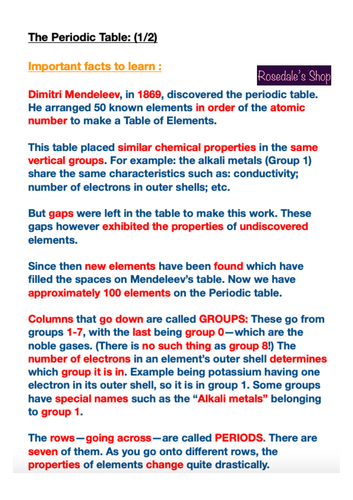ENTIRE Section TWO Chemistry Lesson & Revision BUNDLE for Secondary Schools GCSE & IGCSE for all AQA, Edexcel & OCR
Aimed at secondary school chemistry students, this bundle can be useful for teachers as this comprises of lesson-plan notes, or for students who desire a source of revision notes to study from.
Are you looking for an easy way to study section two of secondary school chemistry? Well, here is a complete, colourful bundle comprising of the following chapters of crazy chemistry: (This is a fantastic bundle, SUPERB for teachers and students alike!)
✔ONE: The periodic Table
What’s included:
-What did Dmitri Mendeleev discover?
-Which year did he make this discovery?
-How many groups does the periodic table contain?
-How many rows does the periodic table have?
-Elements in the same group have the same number of outer electrons…
-Additional sides notes and numerable examples are also presented!
✔TWO: Electron Shells
What it consists of:
-The rules of electron shells
-How to work out electronic configuration?
-An example of nitrogen is presented
-A further example of argon is also shown
-How to draw electronic structures of elements?
-Plus extra useful information + side notes!
✔THREE: (More on) The Periodic Table
What is inside:
-Information with regards to metals
-Information concerning non-metals
-What separates the elements on the periodic table?
-What side of the table are the metals and which side contains the non-metals?
-What are metal oxides?
-What are Group 1 elements classified as?
-As you go down group 1, what happens to the number of electrons and also what occurs to the mass number?
✔FOUR: Electrical Conductivity & Metals
What this comprises of?
-Some facts about the flow of electricity
-When do ionic compounds conduct electricity?
-What holds metals together (with info regarding metallic bonding)?
-Info regarding why metals are good conductors of heat and electricity
-Properties of metals with mini info (Slide over / Malleable / Strong / Light )
✔FIVE: Ionic Bonding
What is discussed inside:
- Definition of ionic bonding & Examples
- Illustration to show the end position of ionic bonding, with the shells and electrons
- How you can tell what charge an element will have
- Formulae of some common ions with their respected charges (that MUST be memorised for exams)
-How does the name of the element change when they lose/gain electrons
- Diagram showing the classic case of sodium and chlorine, becoming sodium chloride
- How do we know the number of electrons gained/lost
✔SIX: Ionic compounds
What is discussed in the section:
-Info on how to work out formula of an ionic compound
-What is the chemical formula of calcium nitrate?
-Dot & Cross Diagrams
-Info about ionic compounds' "lattice structure"
✔SEVEN: Covalent Substances
What is discussed:
-Info regarding Simple Covalent Substances (with Relative Molecular Mass)
-Info on Giant Covalent Substances
-Structure of Diamond, with notes
-Structure of Graphite, with notes
-Notes on C60 Fullerene
✔EIGHT: Covalent Bonding
What this revolves around:
-Description of covalent bonding (here we mention about the: Outer shells, Shared elections, Strong electrostatic attraction, positively/negatively charged electrons, bond types.)
-Examples of covalent bonding (with "dot & cross diagrams" accompanied with sides notes too!). Here we cover: Hydrogen, Chlorine, Hydrogen chloride, Ammonia, Nitrogen, Water, Oxygen Carbon dioxide, Ethane, Methane, Chloromethane & finally Ethene.
All the eight topics presented above are in line with the CGP IGCSE chemistry revision guide, alongside a teacher's additional notes based on each subject. These detailed revision pages, or if you'd like to refer to them as lesson plans, have been compiled by former students who have obtained an A-A* (level 8) grade in their exam papers. So feel assured the work is top-quality, as these were the pages they studied from, to possess some superb, great grades!
You can choose to print off these lessons and teach/study the information within, or have the ultimate access to it online, due to everything comprised being demonstrated clearly, with computerised writing!
NOTE: These are great bunch of resources for GCSE and IGCSE classes, as the work is concise; bright; and a must buy! Moreover, if you are not desiring GCSE / IGCSE content, this is also very useful to teach/study from!
If you download this, and are pleased with it, we would be extremely grateful if you could leave a kind review. *Thank you
Tags: Chemistry, Science, KS3, KS4, #GCSE #IGCSE #Exams #Edexcel #AQA #Chemistry, OCR, Cambridge, Chemistry Study Notes, Revision Notes, lesson plan, revision notes, Electrons, Flow of electricity, Ionic Compounds, Molten, Solution, Metals, Metallic Bonding, Bonding, Conductors of heat and electricity, Delocalised Electrons, Light, Strong, Properties of Metals, Malleable, Electrons slide over, Ionic, Ionic Bonding, Bonding, IONS, ions lost or gained, Charges of ions, Sodium and chlorine to Sodium Chloride, Diagram, charges, elements, electrons, shells, definition and examples, end position of shells and electrons, formula, formulae, Ionic, Ionic Compounds, Ionic, IONS, i formula, formulae, lesson plan, revision notes, Dot and Cross Diagrams, Calcium Nitrate, Magnesium Oxide, Lattice Structure, Simple Covalent Substances, Relative Molecular Mass, Mr, Giant Covalent Substances, Diamond, Graphite, C60 Fullerene, Covalent Substances, Dot and Cross Diagrams, Hydrogen, Chlorine, Hydrogen chloride, Ammonia, Nitrogen, Water, Oxygen Carbon dioxide, Ethane, Methane, Chloromethane & finally Ethene. Outer shells, Shared elections, Strong electrostatic attraction, positively/negatively charged electrons, bond types.
As always, please feel free to ask ANY and ALL questions before downloading.
*All rights reserved by author. Permission to copy for single classroom use only. Electronic distribution limited to single classroom use only. Not for public display.*
We hope to be able to provide further fun, colourful, clear and comprehendible PDFs for you in the future.
Have a good day and make sure to follow us on…
@rosedale_academy_online (Insta)
@RosedaleEdu2020 (Twitter)
Rosedale Academy ~ YouTube/Pinterest

